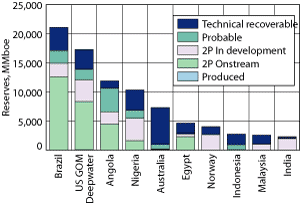Deepwater Statistical Report
Alan Murray, Wood Mackenzie
The “Big 4” deepwater countries are well known. However, it may surprise some to see that the largest discovered reserves are in Brazil, rather than the more heralded US Gulf of Mexico and Angola. This may well be due to reserves that Petrobras has discovered without the involvement of other oil companies. This is now starting to change as companies such as Shell and Chevron are increasingly involved in developing this province.
Brazil stands out, since over half of its reserves are in fields that are already onstream. Brazil has produced from deep water since the late 1980s and the fields that Petrobras discovered in the late 1990s are onstream. A smaller proportion of GOM deepwater fields are onstream, despite the fact that the GOM deepwater has produced almost as long as Brazil. However, since the Gulf of Mexico has a greater number of smaller fields, a smaller proportion of the reserves are in onstream fields.
About one-fifth of the Nigerian deepwater reserves are in fields that are presently onstream. However, this will change as production ramps up through the remainder of this decade. Angola has more onstream fields than Nigeria, since it has been more focused on increasing deepwater production over the last five years.

|
Fig. 1. Reserves for the top 10 deepwater regions. The classifications are field types defined by Wood Mac, which loosely reflect similar reserve types. .
|
|
The remaining countries in Fig. 1 fall into two groups:
• Those with hot spots—Greater Gorgon and Browse basins in Australia, Krishna Godavari basin in India, the Nile delta of Egypt and offshore Sabah in Malaysia
• Those where deepwater volumes represent the expansion of established offshore operations into deeper waters, such as in Norway and Indonesia.
Only Egypt has significant deepwater reserves in producing fields. Most of these reserves are associated with the Egyptian LNG project. Additionally, full production from the giant Ormen Lange field in Norway is due onstream in 2007, and the Dhirubhai project in India is scheduled to commence production in 2008.
Australian deepwater reserves are dominated by gas. LNG is the mostly likely route to monetizing these large fields, but the challenge of high development costs and securing EPC resources cannot be overstated.
|



